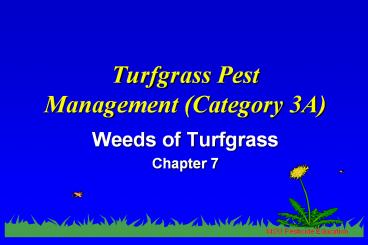Turfgrass Pest Management (Category 3A) - PowerPoint PPT Presentation
Title:
Turfgrass Pest Management (Category 3A)
Description:
Management (Category 3A) Weeds of Turfgrass Chapter 7 Weeds Compete with turf for: Growing space Water Nutrients Sunlight Weed and Site Conditions Weeds can thrive in ... – PowerPoint PPT presentation
Number of Views:218
Avg rating:3.0/5.0
Title: Turfgrass Pest Management (Category 3A)
1
Turfgrass Pest Management (Category 3A)
- Weeds of Turfgrass
- Chapter 7
2
Any plant growing were it is not wanted!
3
Tall fescue in bluegrass stand.
4
Weeds
- Compete with turf for
- Growing space
- Water
- Nutrients
- Sunlight
5
Weed and Site Conditions
- Weeds can thrive in poor conditions
- Shade ground ivy, common chickweed
- Compacted soil knotweed, annual bluegrass
Knotweed
Ground ivy
6
Weeds and Site Conditions
- Wet areas nutsedge, white clover, annual
bluegrass - Heavy wear yarrow, spurge, knotweed
Nutsedge
Spurge
7
Weeds are the result of poor turfgrass
performance, not the cause!
8
The success of weed management depends on
choosing tactics based on the biology of the
specific weed.
9
Weed Biology
- Monocot-narrow leaf
- Parallel leaf veins
- Growing points at or below soil level
- Only herbaceous monocots found in MI
- Dicot-broadleaf
- Veins radiate out from main vein
- Above and below ground growing points
- Woody and herbaceous
10
Monocot
- Grasses
- Annual (crabgrass)
- Perennial (tall fescue)
- Sedge
- Nutsedge
- Lily
- Wild garlic
11
Dicot
- Many families of dicot weed species
- Composite (dandelion)
- Mustard (shepherdspurse)
- Carrot (wild carrot)
- Morning glory (field bindweed)
12
Plant Development Stages
- 1. Seedling
- Tender and vulnerable to stresses
- 2. Vegetative
- Great uptake of water and nutrients
- 3. Seed production
- Slow uptake of water and nutrients directed to
flower, fruit, seed - 4. Maturity
- Little uptake of water and nutrients
- Low energy production
13
The development stage of a weed affects how it
responds to your management tactics.
Seedling Susceptible to cultural
methods. Vegetative Rapid herbicide uptake.
14
Weed Life Cycles
- Annual
- Summer
- Winter
- Biennial
- Perennial
1998
15
Weed Seasonality
- Cool-season plants
- Grow best during cool periods of spring and fall
- Winter annuals some perennials
- Warm-season plants
- Remain dormant or do not germinate until May or
June - Summer annuals some perennials
16
Grass or Sedge?? Weed identification is key to a
successful weed management program. Have
references available.
17
(No Transcript)
18
Keep records of weed populations and
effectiveness of your management efforts.
19
Managing Turf Weeds
- 1. Maintain vigorous turf stands.
- 2. Prevent seed production.
- 3. Prevent seed germination.
20
Managing Turf Weeds
- 4. Eliminate weed seedlings.
- 5. Target susceptible stages of developed weeds
.
21
There are many herbicides marketed for turf weed
management. Understand their characteristics and
read the label carefully.
22
Herbicide Characteristics
- Contact
- Systemic
- Persistent
- Non- persistent
- Selective
- Non- selective
- Pre- emergent
- Post- emergent
23
Herbicide Action and Weed Characteristics
- Growing points
- Leaf shape
- Wax and cuticle
- Leaf hairs
- Deactivation
- Life cycle stage
24
Herbicide Action and Weather
- Control depends on conditions during and after
application - Rains may leach the herbicide
- Light rain may be needed to activate the
herbicide - Sunlight and heat may increase volatility
- Wind increases drift
- Read and follow the label!
25
Read the Label































